“Action is the antidote to despair” – Joan Baez
Introduction
As per Pareto’s Principle (Vital Few, Trivial Many), 80% of the contribution is by 20% people/effort and the remaining 20% of the result is contributed by the balance 80% of the people/effort.
Objective
To do FMEA efficiently and effectively, prioritization is very important. Action Priority (AP) is one such important indicator that decides which risks (Combination of Severity, Occurrence, Detection) should be given more preference than others. Based on it, the organization and relevant stakeholders can decide the sequence of actions that need to be taken.
Definitions
Action Priority: The key objective of ‘Action Priority’ is to choose, how to best prioritize the efforts to reduce the risk. It offers High, Medium and Low priority for action
Detailed Information
FMEA (Failure Mode & Effect Analysis) is a team-oriented, systematic, qualitative and analytical method to identify, analyse and mitigate the technical risks related to the ‘product and manufacturing process design.
The FMEA is the ‘Before the Event’ and not the ‘After the Event’ exercise.
Risk Analysis:
- Severity (S): Severity of the Failure Effect (FE)
- Occurrence (O): Occurrence of the Failure Cause (FC)
- Detection (D): Detection of the Failure Cause (FE) and/or Mode (FM)
Action Priority (AP)
Due to inherent limitations on resources, time, technology and other factors, the organization should choose ‘how to best prioritize these efforts.’
The focus is not the prioritization of High, Medium or Low risk but the prioritization of the need for the action to reduce risk.
- Accounts for all the possible 1000 combinations of Severity (S), Occurrence (O) and Detection (D)
- The first focus is on Severity, followed by Occurrence and Detection
- The logic is Failure Prevention
- The AP table offers High, Medium and Low priority for action
- The risk matrix represents a combination of S & O, S & D and O & D.
- The Action Priority table is similar for DFMEA and PFMEA but differs for FMEA-MSR (Monitoring and System Response)
- Recommended that severity 9 and 10 with AP High and Medium should be reviewed by the management including any recommended action.
Priority High (H):
- Highest priority for review and action.
- Either identify an appropriate action to improve prevention and/or detection
- Or justify and document why current controls are adequate
Priority Medium (M):
- Medium priority for review and action.
- Either identify an appropriate action to improve prevention and/or detection
- Or at the discretion of the organization, justify and document why controls are adequate
Priority Low (L):
- Low priority for review and action.
- Could identify actions to improve prevention or detection controls
Example:
Situation 1: S=8 O=5 D=9 RPN= 360: AP: H
Situation 2: S=10 O=6 D=6 RPN= 360: AP: H
Situation 3: S=6 O=6 D=10 RPN= 360: A: M
How to identify Ranking as per Severity, Occurrence and Detection?
Severity:
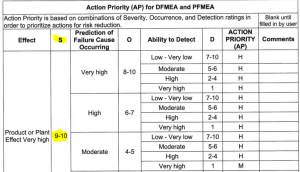
Occurrence:
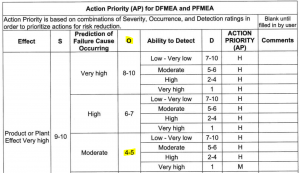
Detection:
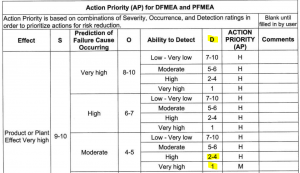
Action Priority:
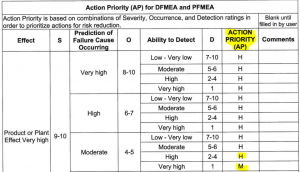
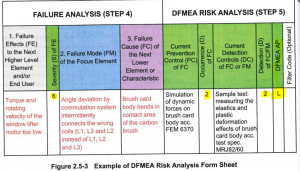
Present Challenges
- How often are the criteria for giving a rating to Severity, occurrence and detection is the real status and not the targeted value!
- Why does the organization feel the pressure of identifying the Action Priority as High?
References:
IATF 16949: 2016
FMEA Handbook (AIAG-VDA 1st Edition June 2019)
Industry Experts
This is the 133rd article of this Quality Management series. Every weekend, you will find useful information that will make your Management System journey Productive. Please share it with your colleagues too.
In the words of Albert Einstein, “The important thing is never to stop questioning.” I invite you to ask anything about the above subject. Questions and answers are the lifeblood of learning, and we are all learning. I will answer all questions to the best of my ability and promise to keep personal information confidential.
Your genuine feedback and response are extremely valuable. Please suggest topics for the coming weeks.
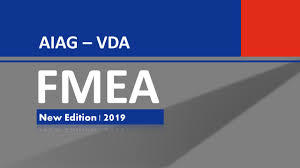
Leave a Reply
You must be logged in to post a comment.